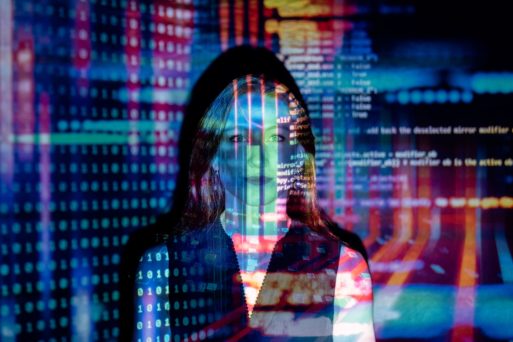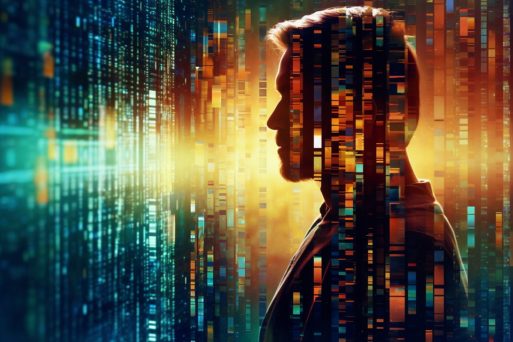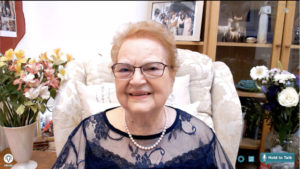
Grief tech companies help your cyber consciousness live on endlessly after you die.
New technology, most often dubbed “grief tech,” could help you or your loved one to live virtually forever. Texts, emails, voicemails, videos, and social media accounts grant us opportunities to maintain a connection with a person after they die. But with the advent of AI, or artificial intelligence, this data can also be used to create a computer-generated copy of us that may eventually supersede the human experience that once created it. As science fiction is quickly becoming reality, how ready are we to upload ourselves or loved ones to a digital afterlife in lieu of mourning a loss? And what are the implications for us when we choose to do so?
Missing the Sound of Someone’s Voice
When a loved one dies, many of us may long to hear the sound of their voice; perhaps even fear that we may someday forget it altogether. Some people continuously play back saved voicemails or recorded audio messages. Others turn to social media streams like Instagram, TikTok, YouTube, and Facebook to see and hear their loved one’s voice again. And a few still rely upon older treasures like audio cassettes, video tapes and compact discs, or CDs.

Aimee believes that resurrecting a digital version of her deceased husband Matt could prove to be worthwhile.
Aimee Kahl is a 40-year-old widow from Divide, Colorado. Her husband, Matt, suffered a tragic death in 2021. Although there are ample videos and audio of Matt available on social media, Aimee chooses to listen to his voicemails on her phone. She said, “It’s the sound of his voice, but he is talking directly to me. It feels more personal.”
Aimee also lost her mother recently. But she does not have the same deep longing to hear her mom’s voice. “There will come a time I will want to hear it,” Aimee admitted. “It’s just too hard right now.”
Dr. Alan Wolfelt is the director of the Center for Loss of Life Transition in Fort Collins, Colorado and has been recognized as one of North America’s leading death educators, authors and grief counselors. Dr. Wolfelt explained that hearing the voice of someone who has died can be both a sad and happy combination. “I call it being sappy. You’re having paradoxical emotionality, and we know the sensory experience of seeing something or hearing something is a powerful way to feel connected to those who go before us.” Still, he advised that those who are grieving a loss should listen with caution. “The key is that as you do that, you’re still acknowledging their death,” he said. “And you are not listening to their voice 24 hours a day.”
The Digital Age of Voice Tech

Those grieving a loss often miss the sound of a loved one’s voice.
While these recordings may be somewhat limited in scope, it is now possible to duplicate your own voice or replicate someone else’s using voice cloning technology. Thanks to AI, creating an extremely accurate digital copy of any voice is easier than ever before. Essentially, machine-learning algorithms analyze and mimic a person’s speech, including tone, pitch, patterns, accents, and even emotions. And once the voice is input and learned by the computer, it can be applied to anything, so we can hear the sound of a deceased person’s voice in new ways.
For example, grandchildren may soon hear stories read by their deceased grandparents through Amazon’s virtual assistant, Alexa. In 2022, the company revealed its AI technology that can reproduce a person’s voice imbued with unique qualities that make it sound more human. The company stated this is possible based on less than a minute of recording.
Voice cloning is also being used in Hollywood. When Val Kilmer lost his voice to throat cancer, he worked with startup Sonantic to create an AI-driven speaking voice for him in the 2022 film, “Top Gun: Maverick.” According to Variety, the company used archival audio footage of Kilmer to generate clear and concise speech for the actor in the movie. Although Kilmer was a willing participant, many AI copies of actors’ voices are being used without their knowledge. Tom Hanks recently warned fans that a deepfake version of his likeness was being used in a dental advertisement without his consent. USA Today reported that AI-generated scams are also on the rise, exploiting victims using copies of familiar voices, who often request money from a person.
Although concerns about copyright are apparent, AI has proven to be a useful tool in the modern world. The majority of us use some form of AI-driven technology daily without much thought or concern, particularly voice-driven virtual assistants like Amazon’s Alexa, Google Assistant and Siri. And the recent explosion of ChatGPT, a powerful AI tool that can string text together to make conversation with a computer program more realistic, has vastly accelerated its use. Large-scale industries like health care and retail outlets now utilize chatbots and virtual agents to personalize service for consumers including recommendations based on personal data they collect.
As of 2022, the AI industry is collectively worth more than $40 billion in the U.S. alone. And Bloomberg.com estimates that the market is poised to grow to approximately $1.3 trillion dollars within the next decade. The U.S. National Science Foundation recently announced a $140 investment to establish seven AI Institutes across the country in conjunction with higher learning institutions. Their goal is to develop a workforce to better understand the technology’s potential uses and risks.
Grief Tech Offers Digital Immortality
Although welcomed by some and shunned by others, a virtual afterlife is now possible. A version of anyone can be created from the digital data created and collected throughout a lifetime. And as chatbots, virtual agents, and avatars become increasingly more humanesque, creating a nearly identical virtual likeness of our living self is eerily possible; one that we can interact with in a lifelike manner.

Ginger Liu, M.F.A. says that while only a handful of competing death tech companies exist, this technology is changing very quickly.
Courtesy: Ginger Liu Photography
Ginger Liu is a Fine Art researcher of photography and artificial intelligence. Her website offers expert interviews and personal insight into the ever-growing world of AI. Liu believes that these so-called death tech platforms are breaking new ground. “If you think about a photograph of a dead relative, it is a 2D static object stuck firmly in the past,” she explained. “A home video of someone deceased records that person alive while moving and talking. AI does something completely different. An AI version of a dead relative is interactive, it talks back, so in some respect, it is not stuck in the frozen past or the present, but has a future.”
As Aimee continues to listen to her late husband’s voicemails, she considers whether grief tech may be the answer to a request he once made to her. Matt told her, “If they could download my brain data to a computer, I would want it to happen.” Aimee has countless photos, recordings, texts, and letters she could upload as a baseline to craft a digital version of Matt in the afterlife. She believes there is still so much more that he could personally share with the world. Plus, Aimee said she is sad about losing the life they once planned to live together, so she is comforted by the thought that she may get to interact with him once again in the future.
Communing with a virtual version of someone after death can be a bittersweet experience. In 2019, a mother engaged with a virtual re-creation of her daughter, who had died at a young age. The experience was broadcast live on a Korean TV documentary, “Meeting You.” The mother, Jang Ji-Sun, interacted with a simulation of her 7-year-old child through a virtual reality headset. According to The Washington Post, Jang Ji-Sun said she would do it again even though the experience was painful.
It was a son’s love for his ailing father in 2016 that first brought the concept of grief tech into the limelight in the United States. James Vlahos was determined to find a way to better cherish the memories of his dying father while video recording him during the last months of his life.
After his father died, Vlahos wrote an article for Wired magazine in July 2017: “A Son’s Race to Give His Dying Father Artificial Immortality.” In it, Vlahos explained how and why he co-created his chatbot, or what he refers to as his “dadbot.” During the process, he wrote, “The Dadbot will no doubt be a paltry, low-resolution representation of the flesh-and-blood man. But what the bot can reasonably be taught to do is mimic how my dad talks — and how my dad talks is perhaps the most charming and idiosyncratic thing about him.” Vlahos also envisioned what it might be like to talk to a far more advanced AI version of his dadbot in the future.
While these technological advancements are quite astounding, Dr. Wolfelt warned that there could be a price to pay if we use it to circumvent grief. “The only way to the other side of grief is through it,” he said. “And I think AI would invite people to go around it.” Dr. Wolfelt firmly believes that our acceptance of death can be liberating. “The paradox of acknowledging death is that you mourn in ways that allow you to eventually live well and love well until you die,” he said. “Denying reality simply does not work. It may provide some temporary relief because you feel more in control of your reality, but you are not!”

Those who want to live virtually forever can choose to interact with their living loved ones as an avatar, hologram or chatbot through video, audio or text.
Digital Afterlife? There’s an App for that
Aside from culling content from random data we someday leave behind, grief tech companies have created applications, or apps, as a means to collect more detail-oriented audio and visuals while still living. Each similarly aims to record answers to varied questions about childhood, relationships, personality, experiences and more. The apps collect the data while also documenting a person’s appearance, facial expressions, gestures, mannerisms, voice inflections, body language, and even heartbeat. These nuances are then used to create each company’s idea of a digital or video representation of a person.
The more data you input, the more interactive your virtual likeness remains after death. Additionally, AI provides a means for those computer-generated algorithms to evolve. Hence, your virtual self may eventually gain an ability to remember, react, learn, and even become somewhat self-aware.
Below are several companies on the forefront of grief technology:
HereAfter AI was founded by Vlahos shortly after he revealed his dadbot in 2016. The company dubs itself an interactive memory app. An AI virtual assistant interviews you about your life. Then, loved ones can hear your meaningful responses and stories when chatting with the virtual version of you after you die.

Some grief tech companies like Somnium Space offer families an opportunity to engage with a deceased loved one inside a computer-generated environment.
Somnium Space offers a new feature in their metaverse, or virtual reality social platform, called “Live Forever” mode. Users can create an avatar of themselves from recorded and encrypted video, so VR users can visit with your avatar eternally online. Founder and CEO Artur Sychov told NPR that he created the mode in memory of his father. Sychov wished he had collected this type of data from him while alive, so he could virtually visit with his father in the metaverse now.
DeepBrain AI launched a grief tech app called Re;memory. They create a hyper-realistic digital human in the likeness of you or your loved one from hours of interview footage captured on camera. Clients then meet with these virtual renderings of their loved one at a Re;memory showroom.
YouOnlyVirtual promises that you “never have to say goodbye.” You can use their app to build your own digital representation of your personality, or Versona, which the company calls “an authentic essence of yourself.” Once created, you can even introduce your virtual Versona into existing text, phone, and video chats while still living. That way, there will be no interruption in communications for loved ones after you die, as the program picks up right where you left off.

StoryFile’s co-founder Stephen Smith’s mother Marina virtually attended her own funeral in July of 2022.
Courtesy: MarinaHSmithFoundation.com
StoryFile offers what they call “conversational video AI,” which will talk back when prompted. While living, you can choose which of the 1600+ questions you want to answer and record on any device, as well as upload other media files to the app. That data is used to create a conversational AI holographic likeness that can be accessed anywhere.
StoryFile’s website invites you to type or ask questions of their spokesperson, an AI chatbot of William Shatner. When I inquired the nodding and waiting Shatner chatbot about what StoryFile is, exactly, Shatner’s video likeness explained using previously recorded answers: “This whole thing is the future … to be able to ask a favorite person in the present day a question and to receive answers as if they were standing in front of you is remarkable. Think of what that means for the future. What will people do with this brand-new technology of 3D artificial intelligence? … Allow your mind to examine the possibilities.”
The Lifenaut Project is a non-profit venture exploring varied possibilities of a digital afterlife; a brainchild of the Terasem Movement Foundation. They are hosting a multi-decade experiment in artificial intelligence and cyber-consciousness. The foundation invites anyone to create and store a mindfile, an app where users can upload data, organize timelines and create an avatar of themselves at no cost.

Bina48 is an advanced social robot based on a sampling of information about a real person. Bruce Duncan talks to her everyday, so she can learn.
All Rights Reserved: Terasem Movement Foundation
Additionally, Lifenaut encourages its users to store a copy of their DNA, or BioFile at no cost (there is a $99 fee to cover the cost of the Bio Collection Kit). Why? Because Bruce Duncan, Managing Director at Terasem Movement Foundation, believes it is possible to achieve more than a virtual continuity of our personal consciousness. As he explained, “The idea behind the biofile is that there may be a time when we can come up with a way to download this cyber consciousness into a stem cell generated body based on our own DNA.” Duncan added, “What we are doing is unique. We are not interested in generic demonstrations based on behaviors, mannerisms and such being recreated. Instead, we are interested in specificity to you.”
The foundation commissioned Hanson Robotics to construct a scientific illustration of their long-term intentions in 2010. Bina48 is a humanoid bust modeled after a 67-year-old African American woman named Bina Rothblatt, a woman still alive today. Bina48 is a life cast of Rothblatt’s physical attributes. And the bot possesses her personality traits obtained from 100 hours of interviews and other data she archived in her mindfile.
Below is a video clip of when the still-living Bina Rothblatt conversed with her robotic doppelganger face to face.
How to Prepare to Live Virtually Forever
If you want to pursue a chance to live virtually forever, it is best to begin the process by archiving all available data. Preserving digital content including audio and video recordings, photographs, and communications from any electronic device is key. Some people choose to email their digital files to themselves and store them in a folder. Or, you can organize and store the data on an external hard drive or cloud-based storage like Google Drive, Google Cloud Storage or iCloud..

If the person is already deceased, you can gather as much written data, audio and visuals of them as you can find they left behind.
Beyond that, you can further explore the various grief tech applications highlighted above or search for more popping up nearly daily. Whether the user is living or dead, all of these companies include some ability to upload, collect, and/or store data, as well as AI encryption of the data, accessibility avenues for families, technical upgrades, and maintenance. A majority of grief tech companies offer users a free trial to get started, so you can explore and discover which digital future representation feels right to you before making an investment. Some also offer gift subscriptions for your loved ones. A few even offer apps for ease of use on iPhone and Android.
Grief Tech Could Alter our Ability to Mourn
Liu, who has interviewed leading experts on the advent of grief tech, said that “Bereavement is a vulnerable time and a desperate time when the bereaved would do anything to bring a dead loved one back to life.” She added, “How we deal with grief is dependent on the technology we use. How do we deal with grief in the AI world when continuing bonds are interactive?”

Dr. Alan Wolfelt believes the best path to integrating loss into our lives includes remembering the deceased using the limited powers of our brains and the full powers of our hearts.
Dr. Wolfelt understands why those grieving would want to keep someone dead alive, but suggests they approach the idea with caution. “Some people might be able to use an AI version to just say hello on the path of grief; to get by and not overuse it,” he said. “But for others, it could be tempting to put on their VR (virtual reality) goggles and go live in the virtual world with them instead of the real world with those who are alive.”
Dr. Wolfelt has witnessed a number of people, who don’t acknowledge the reality of a death. But AI can be particularly tempting to keep someone alive in an unhealthy manner. In his book “Complicated Grief: How to Understand, Express and Reconcile Your Especially Difficult Grief” Wolfelt warns of the dangers of what he calls “encamped grief.” He explained, “Whether consciously or unconsciously, you’re trying to keep somebody alive that’s dead. And the problem is if you keep somebody dead alive, you become at risk for being dead yourself. Death may not be the greatest loss in life. The greatest loss is what can die inside you while you live.”
Liu notes there are cases of AI bot users who cannot make the distinction between reality and the artificial. Bloomberg News recently spotlighted the dangers AI company promises pose for users, who may too easily believe the interactions are sentient and real. Liu thinks there should be more accountability by grief tech companies to protect users, who may be particularly vulnerable while mourning or if suffering from other limitations that pose a risk. “Big death tech companies have come under scrutiny for not putting measures into place that can detect mental health issues,” she said.
Other Red Flags Posed by AI
“It’s hard to predict the future,” said Duncan of Terasem Movement Foundation. “No one could have foreseen ChatGPT; a burst of innovation that could change the trajectory of everything.”

Bruce Duncan says The Terasem Movement Foundation is committed to operating in an ethical, transparent manner.
But some experts and tech moguls forewarn that the use of AI could be catastrophic. Elon Musk has repeatedly spoken out about the dangers it poses. A recent Time Magazine feature delves into the many reasons why he fears AI’s abilities. Musk worries these systems could become politically indoctrinated or worse, could turn hostile toward the human species. In his quest to better understand the looming technology and its implications, Musk started his own AI company, xAI, in July 2023.
According to a recent poll on AI by Monmouth University, Americans are pessimistic about the benefits versus risks it may pose. Results show that only 1 in 10 Americans believe computer scientists’ ability to develop AI would do more good than harm to society. Aside from deepfake use of someone else’s likeness and fears linked to its future growth potential, AI privacy and security concerns are also on the rise. Mark McCreary, the co-chair of the privacy and data security practice at law firm Fox Rothschild LLP, told CNN that “The privacy considerations with something like ChatGPT cannot be overstated.” McCreary and others urge users to limit what they tell a chatbot and to review AI tech privacy policies carefully.
Privacy issues may be more of an ethical concern when it comes to grief tech, as AI-generated copies of deceased loved ones can be made without their permission. But even though the loss of autonomy poses questions, Duncan of Terasem Movement Foundation remains optimistic that this industry will continue to grow. “The possibility of extending personal consciousness beyond our biological expiration date has been a topic of interest and conversations by science fiction writers, philosophers, futurists and transhumanists for many years. For many of us, the prospect of the opportunity to continue loving the people we love and to journey further in exploring life will be compelling.”
Mourning is Key to Living Life after Loss
Liu ultimately understands the shared craving many of us may have for immortality. “For however long human beings have lived, none of us can accept the fact that we will die,” she said. “It comes as a shock and we are never equipped to deal with it.” But as compelling as the continuance of life may be in any form, Dr. Wolfelt firmly believes we must stop buying into the illusion that we can live forever and embrace our human mortality; death is not optional.
Whether you ultimately choose to stay connected to a deceased loved one in some virtual form or not, Dr. Wolfelt strongly encourages us to journey through the six needs of mourning in order to heal. They are a “to-do list” for actively expressing your grief. “We must first acknowledge the reality of the death,” Dr. Wolfelt said. “Only then can we befriend the pain. From there, we begin to shift our relationship from presence to memory, leading us to develop a new self-identity and search for new meaning or life purpose. Additionally, we gain the ability to more easily seek and accept ongoing support we need from others.”
And even though grieving widow Aimee agrees the implications remain greatly unknown, she thinks a digital recreation of her husband may still be a worthwhile endeavor. According to Aimee, Matt would surely agree that an AI version of himself would be pretty badass!

 Are We Ready to See, Hear and Chat With Deceased Loved Ones Virtually Forever?
Are We Ready to See, Hear and Chat With Deceased Loved Ones Virtually Forever?


 “Help Me, Helen”
“Help Me, Helen”

 “As Tears Go By” by Marianne Faithfull
“As Tears Go By” by Marianne Faithfull














